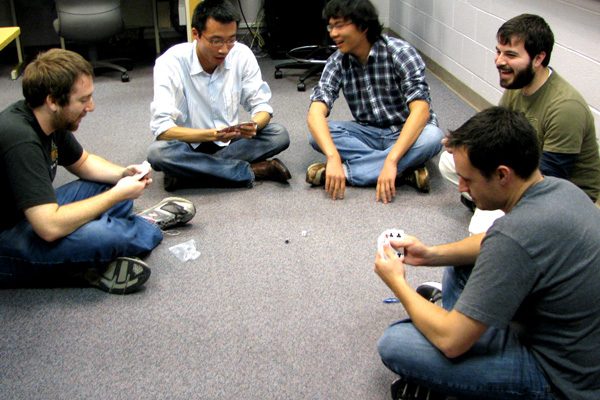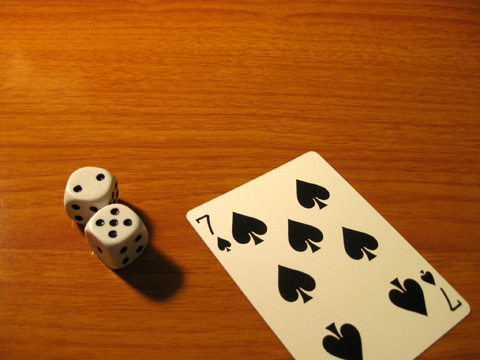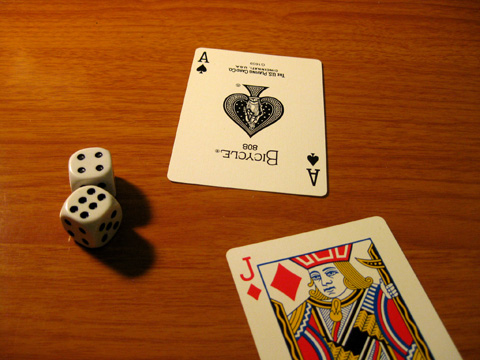Friend or Foe?

Playtesters (circle from left): Aaron Kahn, Jack Chang, Miaoqi Zhu, Nicholas Matthews, and Steve Burns
What is the "singularity" of one porker deck plus 2 dice? In a poker deck, the variation of numbers ranges from 1 (Ace) to 13 (King), while that of two dice together is from the minimum of 2 (1+1) to the maximum of 12 (6+6). Hence, any number combined by two dice can cover all numbers possible in one poker deck-- except 1 and 13. So I wanted to develop a card game using this singularity. In this game, players get to either attack or befriend each other (help oneself by helping another).
p.s. The word singularity is actually from math/calculus: "an exceptional set where it fails to be well-behaved in some particular way" (from Wikipedia). But essentially, this is just a card game based on the observation upon a poker deck and two dice together. Hopefully this turns out to be a fun and creative game.
Other Info:
- Project year: 2008
Goal
The first player to get rid all of his/her own cards wins.
Game Setup
One poker deck, two dice, preferably 4+ players. (The following assumes there are 4 players A, B, C, and D.)
Cards are shuffled and dealt out to each player evenly. Each player then takes turn to roll the two dice.
Rule I (The Basic Gameplay)
After rolling the two dice in his turn, the player can discard his card(s) if he has card(s) that matches any of the following two criteria:
Rule III (The Foe Rule)
If a player passes in his turn, i.e. he doesn't have any card(s) that matches any of the two criteria, or, for strategic reasons, he chooses not to discard the card(s) that matches any of the two criteria, any other players who has card(s) matching to either one of the criteria can shout "Foe!".
He who calls "Foe!" first can then discard the card(s) accordingly. This also means the player who just passed gets "attacked"-- he needs to collect all the card in the discard pile and the game continues.
The first player to get rid all of his/her own cards wins.
Game Setup
One poker deck, two dice, preferably 4+ players. (The following assumes there are 4 players A, B, C, and D.)
Cards are shuffled and dealt out to each player evenly. Each player then takes turn to roll the two dice.
Rule I (The Basic Gameplay)
After rolling the two dice in his turn, the player can discard his card(s) if he has card(s) that matches any of the following two criteria:
- He can discard TWO cards whose numbers are exactly the same with the combination of the two dice.
Example: Dice are 2 and 5. Cards come with a 2 and a 5 (regardless of suits) can be discarded.

- He can discard ONE card whose number equals the sum of the numbers of the two dice.
Example: Dice are 2 and 5. A card with a number of 7 (=2+5, regardless of suits) can be discarded.

- If the player can't discard any of his card(s) by any of the two criteria above, he needs to pass.
- After the player finishes his turn by discarding his cards(s) or passing, the next player then takes his turn to roll the dice.
- Example: Dice are 4 and 6. Player A says "Friend my card 3?". Player B who shout "Friend!" first can discard King(13) together with the card 3 from player A because 13-3=10=4+6.

- Example: Dice are 4 and 6. Player B says "Friend my card Joker?". Player C who shout "Friend!" first can discard Ace(1) together with the card Joker from player B because 11-1=10=4+6.

Rule II (The Friend Rule)
As you can tell, so far Aces and Kings can't be discarded: none of the combinations of two dice rolled can generated a 1(Ace) or a 13(King). So here comes the "Friend Rule".
In a particular turn, if the player who rolls the dice doesn't have the matching card(s), he can ask "Friend my card N?" by saying what one card he wants to discard with number N. Another player who shout "Friend!" first can discard a card of number 1(Ace) or King(13). Ace is used for getting subtracted, King is used for subtracting, i.e. 13-N or N-1 should equal to the number of the two dice combined.
Then both the card N (from the player in this turn) and the card Ace or King (from another player who offers friendly help) can be discarded in this turn.
Rule III (The Foe Rule)
If a player passes in his turn, i.e. he doesn't have any card(s) that matches any of the two criteria, or, for strategic reasons, he chooses not to discard the card(s) that matches any of the two criteria, any other players who has card(s) matching to either one of the criteria can shout "Foe!".
He who calls "Foe!" first can then discard the card(s) accordingly. This also means the player who just passed gets "attacked"-- he needs to collect all the card in the discard pile and the game continues.
- Example: Dice are 2 and 5. Player A passed. Player C shout "Foe!" first and can discard a 2 and a 5 (regardless of suits) to "attack" the player A who just passed. Player A then needs to collect all the cards in the discard pile.

- Example: Dice are 2 and 5. Player A passed. Player D shout "Foe!" first and can first can discard a card of 7(regardless of suits) to "attack" the player A who just passed. Player A who just passed then needs to collect all the cards in the discard pile.

- The 1st playtest shows that "passes" are made more than expected during the game, which is reasonable because the randomness (from the two dice) determines what cards can be discarded.
But after more playtests with more different players, it also shows people started to enjoy the fun of this game: once players are more familiar with the rules and gameplay, they think more strategically about if and when they should befriend or attack other players.
For example: you get to discard some cards by attacking another player (with the use of the Foe Rule), but that also means you'll have less available cards when you get your turn. Special cards (Aces and Kings) can only be used with other player's card (with the use of the Friend Rule). Yes you get to discard a special card, but do you really want to help another player to finish his game earlier by reducing his number of cards?
- Another comment made was that this can be a simple educational tool for kids. Simple as in it only takes a poker deck plus two dice. They don't cost much and they are portable. It can be an enducational tool because it uses basic math (addition/substraction) within a social context.
- Jack Chang
game design and visualization
- Special thanks to
Thom Gillespie, Jake Enfield, Aaron Kahn, Miaoqi Zhu, Nicholas Matthews, and Steve Burns
